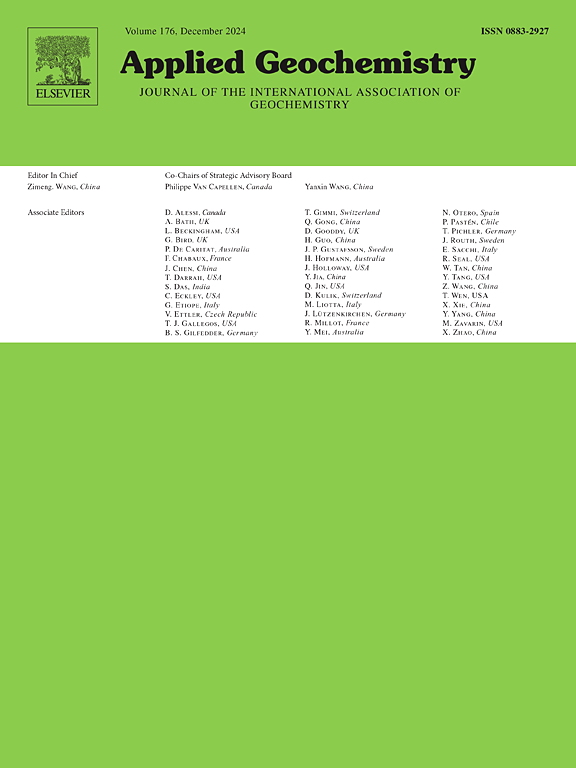探索非生物非催化多酚-美拉德腐殖质在有限光照环境下的作用
IF 3.4
3区 地球科学
Q1 GEOCHEMISTRY & GEOPHYSICS
引用次数: 0
摘要
涉及多酚美拉德前体的非生物腐殖质化导致腐殖质样物质(hss)的形成。先前的研究已经对催化或矿物相关途径进行了研究,尽管非催化非生物途径在光限制环境中的物理化学作用仍未被探索。目前研究的是儿茶酚(游离多酚)和美拉德前体(葡萄糖和amp;甘氨酸)合成hss。在儿茶酚存在的情况下,单线态氧(1O2)的产生仅在温和的温度和限光条件下进行,与光化学或芬顿型反应无关。光谱分析显示主要存在脂肪族部分,与超高分辨率质谱(UHRMS)数据一致。缩聚反应中CO2浓度升高,pH值下降,表明芳烃环断裂,羧基形成,芳烃转化为脂肪片段。此外,Van Krevelen分析显示HLS的O/C比值增加。值得注意的是,关键成分包括酸性和葡萄糖氧化产物,以及一些美拉德反应中间体(肯德里克质量分析证实)。该研究提供了一种新的非催化性非生物腐殖化途径,证实了光辅助和光化学过程最小的环境,如地下土壤和地下水。本文章由计算机程序翻译,如有差异,请以英文原文为准。

Exploring abiotic non-catalytic polyphenol-Maillard humification in light-limited environment
Abiotic humification involving polyphenol-maillard precursors leads to the formation of Humic-like substances (HLSs). Previous research has been conducted on catalytic or mineral-associated pathways, although the physicochemical role of noncatalytic abiotic pathway in light-limited environments remains unexplored. Current study investigates the noncatalytic polycondensation reaction between catechol (free polyphenol) and Maillard precursors (glucose & glycine) to synthesize HLSs. In the presence of catechol, singlet oxygen (1O2) production solely derived the reaction at mild temperature and light-limited conditions, independent of photochemical or Fenton-type reactions. Spectroscopic analyses revealed a dominant presence of aliphatic moieties, consistent with ultra-high-resolution mass spectrometry (UHRMS) data. Polycondensation reaction released elevated CO2 levels and decline in pH, indicating aromatic ring cleavage, carboxyl group formation and transformation of aromatics into aliphatic fragments. Additionally, Van Krevelen analysis showed increased O/C ratio in HLS. Notably, the key components included acidic and glucose oxidation products, along with some Maillard reaction intermediates (confirmed with Kendrick Mass analysis). This study provides a novel noncatalytic abiotic humification pathway, corroborating with environments where light-assisted and photochemical processes are minimal such as subsurface soils and underground water.
求助全文
通过发布文献求助,成功后即可免费获取论文全文。
去求助
来源期刊

Applied Geochemistry
地学-地球化学与地球物理
CiteScore
6.10
自引率
8.80%
发文量
272
审稿时长
65 days
期刊介绍:
Applied Geochemistry is an international journal devoted to publication of original research papers, rapid research communications and selected review papers in geochemistry and urban geochemistry which have some practical application to an aspect of human endeavour, such as the preservation of the environment, health, waste disposal and the search for resources. Papers on applications of inorganic, organic and isotope geochemistry and geochemical processes are therefore welcome provided they meet the main criterion. Spatial and temporal monitoring case studies are only of interest to our international readership if they present new ideas of broad application.
Topics covered include: (1) Environmental geochemistry (including natural and anthropogenic aspects, and protection and remediation strategies); (2) Hydrogeochemistry (surface and groundwater); (3) Medical (urban) geochemistry; (4) The search for energy resources (in particular unconventional oil and gas or emerging metal resources); (5) Energy exploitation (in particular geothermal energy and CCS); (6) Upgrading of energy and mineral resources where there is a direct geochemical application; and (7) Waste disposal, including nuclear waste disposal.
 求助内容:
求助内容: 应助结果提醒方式:
应助结果提醒方式:


